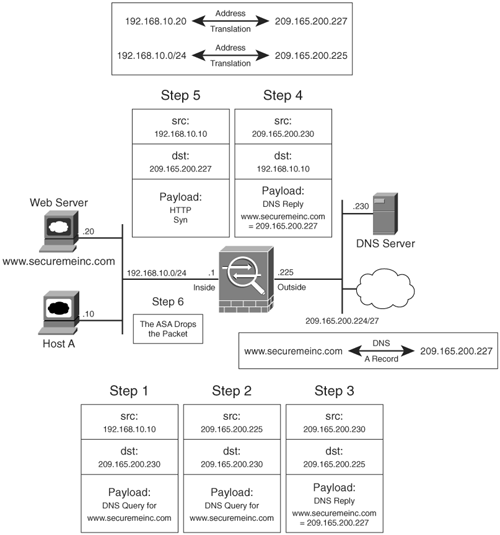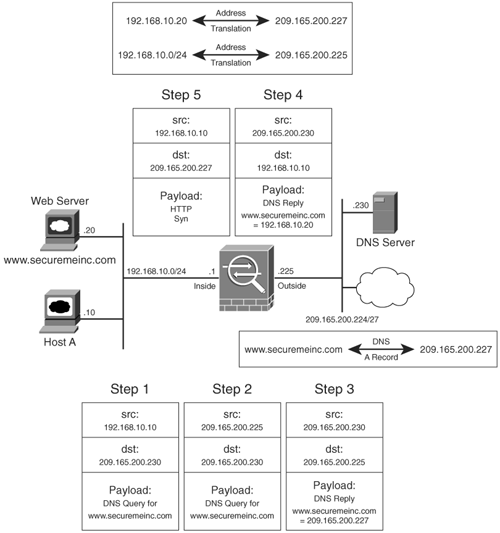DNS Doctoring
In many network deployments, the DNS servers and DNS clients are located on different subnets which are connected through the security appliance, setup for address translation. This is illustrated in Figure 5-20. The web server (www.securemeinc.com) and the web clients are toward the inside network, whereas the DNS server is on the outside network. The real IP address of the server is 192.168.10.20 and the translated public address is 209.265.200.227.
Figure 5-20. DNS and NAT Without DNS Doctoring

The problem arises when a web client (Host A) tries to access the web server using its host name. In this scenario, the following sequence of events occurs:
- Host A sends a request to the DNS server, inquiring about the IP address of the web server.
- The source IP address is translated to 209.165.200.225 using dynamic PAT.
- The DNS server replies with the translated IP address of the web server (209.165.200.227) as a type A DNS record.
- The security appliance translates the destination IP address to 192.168.10.10 (Host A's IP address).
- The client, not knowing that the web server is on the same subnet, tries to connect to the public IP address.
- The security appliance drops the packets, because it does not allow packet redirection on the same interface.
The DNS doctoring feature of Cisco ASA inspects the data payload of the DNS replies and changes the type A DNS record (IP address sent by the DNS server) to an address specified in the NAT configuration. In Figure 5-21, the security appliance modifies the IP address in the payload from 209.165.200.227 to 192.168.10.20 (Step 4) before forwarding the DNS reply to the client. The client uses this address to connect to the web server.
Figure 5-21. DNS and NAT with DNS Doctoring

The DNS doctoring feature can be enabled by adding the dns keyword to the static and/or nat commands that are translating the real IP address of the server. In Example 5-44, a static NAT entry is set up to translate a real IP address from 192.168.10.20 to a global IP address, 209.165.200.227. The dns keyword is specified to enable DNS doctoring for this server.
Example 5-44. Configuration of DNS Doctoring
Chicago(config)# static (inside,outside) 209.165.200.227 192.168.10.20 netmask 255.255.255.255 dns
Note
The security appliance also supports DNS doctoring using the alias command. However, the recommended method is to use DNS doctoring with static and nat commands, because the alias command will be deprecated in the future.
DNS doctoring can also be set up for the outside NAT connections. This is useful in deployments where the DNS server and the content (such as web or e-mail) server reside on the outside network and the clients are located on the inside network, as shown in Figure 5-22.
Figure 5-22. DNS Doctoring for Outside NAT

The following sequence of events takes place when a host on the inside network connects to a web server on the outside network:
- Host A sends a DNS query to the server to resolve www.securemeinc.com.
- The security appliance translates the source IP address to 209.165.200.225 before forwarding the packet to the DNS server.
- The DNS server replies with the IP address of the web server, 209.165.201.20, in the data payload.
- The security appliance changes the embedded IP address to 192.168.10.20 before it forwards the reply to Host A.
- The client sends a TCP SYN packet to connect to the web server using as the destination IP address 192.168.10.20.
- As the packet passes through, the security appliance changes the destination IP address to 209.165.201.20. The packet gets routed to the Internet before it reaches the web server.
Example 5-45 shows the respective configuration of the security appliance to enable DNS doctoring for outside NAT.
Example 5-45. Configuration of DNS Doctoring for Outside NAT
Chicago(config)# static (outside,inside) 192.168.10.20 209.165.201.20 netmask 255.255.255.255 dns
Part I: Product Overview
Introduction to Network Security
- Introduction to Network Security
- Firewall Technologies
- Intrusion Detection and Prevention Technologies
- Network-Based Attacks
- Virtual Private Networks
- Summary
Product History
- Product History
- Cisco Firewall Products
- Cisco IDS Products
- Cisco VPN Products
- Cisco ASA All-in-One Solution
- Summary
Hardware Overview
Part II: Firewall Solution
Initial Setup and System Maintenance
- Initial Setup and System Maintenance
- Accessing the Cisco ASA Appliances
- Managing Licenses
- Initial Setup
- IP Version 6
- Setting Up the System Clock
- Configuration Management
- Remote System Management
- System Maintenance
- System Monitoring
- Summary
Network Access Control
- Network Access Control
- Packet Filtering
- Advanced ACL Features
- Content and URL Filtering
- Deployment Scenarios Using ACLs
- Monitoring Network Access Control
- Understanding Address Translation
- DNS Doctoring
- Monitoring Address Translations
- Summary
IP Routing
Authentication, Authorization, and Accounting (AAA)
- Authentication, Authorization, and Accounting (AAA)
- AAA Protocols and Services Supported by Cisco ASA
- Defining an Authentication Server
- Configuring Authentication of Administrative Sessions
- Authenticating Firewall Sessions (Cut-Through Proxy Feature)
- Configuring Authorization
- Configuring Accounting
- Deployment Scenarios
- Troubleshooting AAA
- Summary
Application Inspection
- Application Inspection
- Enabling Application Inspection Using the Modular Policy Framework
- Selective Inspection
- Computer Telephony Interface Quick Buffer Encoding Inspection
- Domain Name System
- Extended Simple Mail Transfer Protocol
- File Transfer Protocol
- General Packet Radio Service Tunneling Protocol
- H.323
- HTTP
- ICMP
- ILS
- MGCP
- NetBIOS
- PPTP
- Sun RPC
- RSH
- RTSP
- SIP
- Skinny
- SNMP
- SQL*Net
- TFTP
- XDMCP
- Deployment Scenarios
- Summary
Security Contexts
- Security Contexts
- Architectural Overview
- Configuration of Security Contexts
- Deployment Scenarios
- Monitoring and Troubleshooting the Security Contexts
- Summary
Transparent Firewalls
- Transparent Firewalls
- Architectural Overview
- Transparent Firewalls and VPNs
- Configuration of Transparent Firewall
- Deployment Scenarios
- Monitoring and Troubleshooting the Transparent Firewall
- Summary
Failover and Redundancy
- Failover and Redundancy
- Architectural Overview
- Failover Configuration
- Deployment Scenarios
- Monitoring and Troubleshooting Failovers
- Summary
Quality of Service
- Quality of Service
- Architectural Overview
- Configuring Quality of Service
- QoS Deployment Scenarios
- Monitoring QoS
- Summary
Part III: Intrusion Prevention System (IPS) Solution
Intrusion Prevention System Integration
- Intrusion Prevention System Integration
- Adaptive Inspection Prevention Security Services Module Overview (AIP-SSM)
- Directing Traffic to the AIP-SSM
- AIP-SSM Module Software Recovery
- Additional IPS Features
- Summary
Configuring and Troubleshooting Cisco IPS Software via CLI
- Configuring and Troubleshooting Cisco IPS Software via CLI
- Cisco IPS Software Architecture
- Introduction to the CIPS 5.x Command-Line Interface
- User Administration
- AIP-SSM Maintenance
- Advanced Features and Configuration
- Summary
Part IV: Virtual Private Network (VPN) Solution
Site-to-Site IPSec VPNs
- Site-to-Site IPSec VPNs
- Preconfiguration Checklist
- Configuration Steps
- Advanced Features
- Optional Commands
- Deployment Scenarios
- Monitoring and Troubleshooting Site-to-Site IPSec VPNs
- Summary
Remote Access VPN
- Remote Access VPN
- Cisco IPSec Remote Access VPN Solution
- Advanced Cisco IPSec VPN Features
- Deployment Scenarios of Cisco IPSec VPN
- Monitoring and Troubleshooting Cisco Remote Access VPN
- Cisco WebVPN Solution
- Advanced WebVPN Features
- Deployment Scenarios of WebVPN
- Monitoring and Troubleshooting WebVPN
- Summary
Public Key Infrastructure (PKI)
- Public Key Infrastructure (PKI)
- Introduction to PKI
- Enrolling the Cisco ASA to a CA Using SCEP
- Manual (Cut-and-Paste) Enrollment
- Configuring CRL Options
- Configuring IPSec Site-to-Site Tunnels Using Certificates
- Configuring the Cisco ASA to Accept Remote-Access VPN Clients Using Certificates
- Troubleshooting PKI
- Summary
Part V: Adaptive Security Device Manager
Introduction to ASDM
- Introduction to ASDM
- Setting Up ASDM
- Initial Setup
- Functional Screens
- Interface Management
- System Clock
- Configuration Management
- Remote System Management
- System Maintenance
- System Monitoring
- Summary
Firewall Management Using ASDM
- Firewall Management Using ASDM
- Access Control Lists
- Address Translation
- Routing Protocols
- AAA
- Application Inspection
- Security Contexts
- Transparent Firewalls
- Failover
- QoS
- Summary
IPS Management Using ASDM
- IPS Management Using ASDM
- Accessing the IPS Device Management Console from ASDM
- Configuring Basic AIP-SSM Settings
- Advanced IPS Configuration and Monitoring Using ASDM
- Summary
VPN Management Using ASDM
- VPN Management Using ASDM
- Site-to-Site VPN Setup Using Preshared Keys
- Site-to-Site VPN Setup Using PKI
- Cisco Remote-Access IPSec VPN Setup
- WebVPN
- VPN Monitoring
- Summary
Case Studies
EAN: 2147483647
Pages: 231
